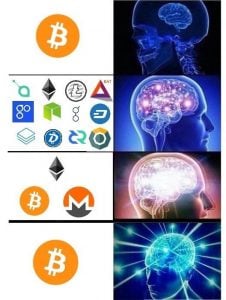Ghost Towns on the Blockchain
Blockchain as a technology is still in its infancy. The next generation of chains, side-chains and off-chain layers are either under construction or fresh out the gate. It will take time to see whether their claims of high throughput and scalability stand scrutiny. An examination of the blockchains that have been in operation for several years makes for dismal reading. Outside of the top six, blockchains are seeing very little action.

Ethereum was the clear leader in number of transactions per second at the time of writing, reporting over 980,000 transactions in the past 24 hours, versus bitcoin’s 240,000. One way to report that statistic would be “Ethereum nears 1 million transactions a day”. Another would be “Blockchains haven’t even reached 1 million transactions a day”. Moreover, a closer examination of ethereum’s numbers shows that the number of ‘real’ transactions may be significantly lower.

Blockchains Upon Blockchains
 As many as 10% of ethereum’s total daily transactions are believed to be the work of a large mixer controlled by one entity. The origin of these temporary ETH addresses is unknown, but whatever the reason, it serves to artificially inflate the daily transaction volume. Another 20% was taken up by Cryptokitties at its peak, though its activity has since reduced to a purr.
As many as 10% of ethereum’s total daily transactions are believed to be the work of a large mixer controlled by one entity. The origin of these temporary ETH addresses is unknown, but whatever the reason, it serves to artificially inflate the daily transaction volume. Another 20% was taken up by Cryptokitties at its peak, though its activity has since reduced to a purr.
With over two dozen ICOs taking place on the ethereum blockchain every day, a good proportion of the transaction volume is people sending ether to buy into crowdsales, or purchasing newly released ICO tokens on Etherdelta; almost 5% of ethereum’s daily transaction volume comes from Etherdelta.

In other words, many of the people using the ethereum blockchain are using it to invest in the construction of more blockchains. It’s all very meta. Once these blockchains are completed, many of these will also be looking to launch ICOs on their fledgling platforms…for new blockchains. We’re in danger of reaching hyperblockchainization: all the chains but none of the traffic.

The World’s Original Blockchain Is Also Its Best
One of the few benefits of rising transaction fees is that it’s eliminated a lot of the spam on the bitcoin network. People are using the bitcoin blockchain as an actual utility, not to pay for kittens or pile into the next vaporware crowdsale. Thus, despite ranking a distant second to ethereum in terms of volume, the value of bitcoin transactions is greater, both in dollar value and in terms of function served. In the last 24 hours, $10.6 billion of bitcoin was sent, versus $8.2 billion for ethereum.
 Outside of the top six, there is little evidence that blockchains are seeing much use. Onchain FX records just 5,200 monero transactions over the past 24 hours, 9,000 zcash, and 12,400 dash. In total, the top 20 blockchains have a daily transaction average of about two million. To put that into context, that’s 1 in every 3,750 people in the world using a blockchain in a typical day, or 0.027%.
Outside of the top six, there is little evidence that blockchains are seeing much use. Onchain FX records just 5,200 monero transactions over the past 24 hours, 9,000 zcash, and 12,400 dash. In total, the top 20 blockchains have a daily transaction average of about two million. To put that into context, that’s 1 in every 3,750 people in the world using a blockchain in a typical day, or 0.027%.
As a recent Coinmetrics blog postmakes clear, estimating chain transaction volume isn’t easy, so there’s a large margin for error. What is evident is that the “blockchain revolution” we read so much about on glossy ICO websites isn’t even in sight, let alone here. Everyone might be talking about blockchains. But outside of bitcoin, ethereum, and a handful of others, no one is using them.
Comments
Post a Comment